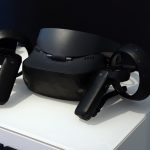Industrial Giant Siemens Seeks VR/AR Startups To Help Revolutionize Manufacturing

During this, the first year when virtual reality headsets are widely available, games are the lure commonly spurring consumers to try VR. And that’s spreading beyond digital games. Early next month, some headset owners will be able to watch finals matches in basketball and other sports recorded for VR at the Rio 2016 Olympic Games.
But the advent of relatively inexpensive VR headsets is also boosting exploration of business opportunities in more sober industrial sectors, including aerospace, health care, and vehicle design. Just before NBC announced the first-time coverage of Olympic competitions in VR this summer, German industrial giant Siemens, founded in 1847, announced it was opening up its Silicon Valley accelerator program to virtual reality and augmented reality startups.
Not that Seimens is a late convert to the potential of VR in industry. The global company, whose activities range across oil and gas, power generation, manufacturing, and health care, has also been involved in developing virtual reality services for business customers for as long as 15 years, Siemens digital manufacturing expert Mohsen Rezayat says.
Siemens helps large companies such as aerospace manufacturer Boeing and tractor maker Caterpillar to construct hybrid virtual and physical environments called “CAVEs,” where they can train operators to work safely with their complex equipment, Rezayat (pictured above) says. Images of real objects and physical settings are projected onto the walls of an actual building that houses a CAVE, where visitors wearing sensors on their hands can rehearse the experience of driving a Caterpillar through a field, for example.
A CAVE, or “cave automatic virtual environment,” often combines 3D imaging with wall projection to enhance the illusion of interacting with real objects. Specialty businesses such as Marshalltown, IA-based Mechdyne also construct these rooms.
Creating CAVE environments can cost more than $ 1 million, Rezayat says. But the caves can also prevent extremely expensive mistakes and their consequences, like the multi-billion-dollar loss of a satellite, worker injuries and deaths, or a rocket blowing up an entire plant, he says.
“I’ve been there when this has happened,” Rezayat says.
These virtual training environments can now be created at a much lower expense due to the commercial launch of long-awaited consumer VR headsets such as Oculus Rift and Samsung’s Gear VR, Rezayat says. The high-end Oculus Rift sells for $ 599; the Gear VR goes for $ 100.
“The prices are coming down, and they’re going to get even cheaper,” Rezayat says. This opens up a new market for Siemens’ VR offerings, he says. “We can go beyond our large customers such as Boeing and Caterpillar, and bring it to the masses.”
Siemens is looking for VR and augmented reality startups whose innovations might dovetail with its own plans to digitize manufacturing and product innovation through cutting-edge technology. In late June, the company invited VR and AR founders to apply to the Siemens Frontier Partner Program, a Berkeley, CA-based accelerator that already welcomes startups in 3D printing and robotics. The program is based at Siemens’ Berkeley Technology-to-Business Center, which was founded in 1999.
Early-stage startups admitted to the selective Frontier program get free access for a year to a software suite called Siemens PLM Software, which is designed to speed up the development of new products from concept to prototype and testing. The product lifecycle management software also includes marketing features for companies that have products ready for commercialization. Rezayat, whose title is Chief Solutions Architect at Siemens PLM Software, a Plano, TX-based company unit, is a co-founder and lead member of the Frontier program.
Successful applicants to the Frontier program don’t receive any money upfront, but they consult with Siemens experts, and may be invited to present their work to Siemens customers. The Frontier program started with the idea that it would draw most of its startups from the United States, Rezayat says, but later opened up eligibility when it drew applicants from “all over the world.”
Some participants have landed venture firm investments and negotiated licensing agreements with Siemens, Rezayat says. “We’re putting their technology into our products.”
The driving force behind Siemens’ new outreach to VR and AR startups is customer demand, Rezayat says. Customers are asking the company how they can use these technologies, he says.
A survey of more than 100 manufacturers published in January by PricewaterhouseCoopers (PwC) lends some support to Rezayat’s sense of the demand. More than a third of the companies responding said they’re using VR technology or have plans to use it within three years. The most common use of VR was in product design and development. The manufacturers reported a similar interest in augmented reality.
But close to 90 percent of the surveyed companies predicted that at most half of US manufacturers would deploy VR or augmented reality tools during the decade to come. More than a third of those surveyed by PwC expect that less than a tenth of manufacturers will be using these technologies. Those who were holding back from investing in VR and AR said the cost was too high, the technology was not … Next Page »
(31)













